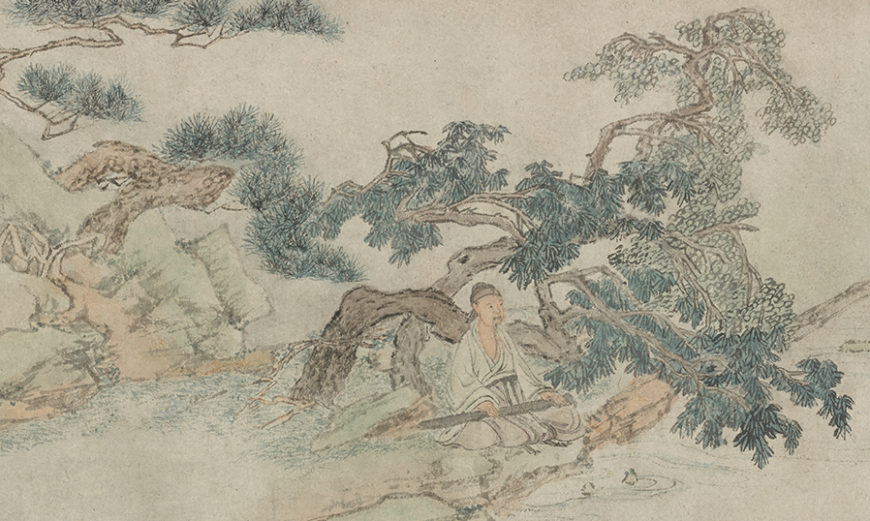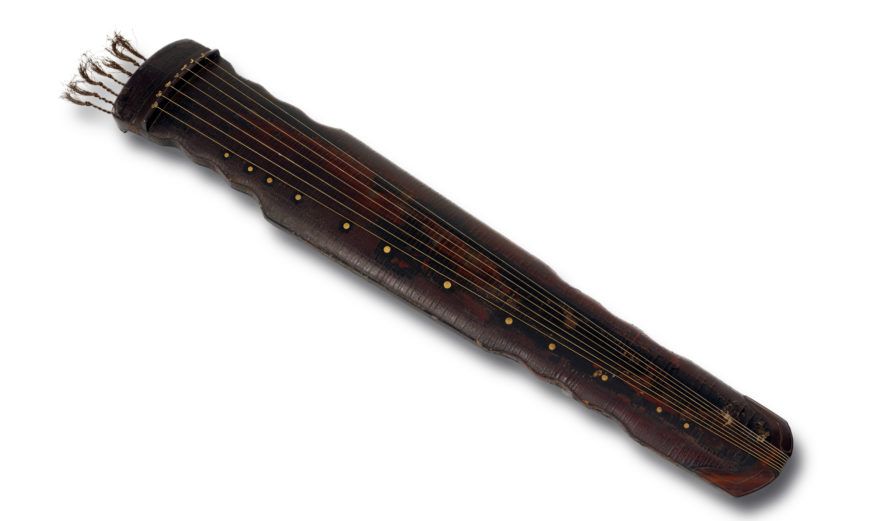
Copy after Qiu Ying 仇英 (c. 1494–1552), Playing the Zither Beneath a Pine Tree (detail), Ming dynasty, late 16th-early 17th century, ink and color on paper, China, 22.2 x 105.3 cm (Freer Gallery of Art, Smithsonian Institution, Washington, DC: Purchase — Charles Lang Freer Endowment, F1953.84)
At the center of the painting, a robed scholar kneels on the ground beneath a twisted pine. The pine claws in the air like a dragon. The scholar is quietly playing a qin (“chin”), or zither, while looking into the void of the far distance. The scholar with his qin is the focus of the painting. Preceding and following this scene is a great bare expanse. There is no audience. Facing the water with hills behind, the scholar plays by himself and for himself. Through the playing of the qin, he is quietly communicating with his surroundings. The dramatic rendering of the scene is probably meant to trigger a poetic mood of the original viewer, as described in a famous poem: “I walk to where the water ends; and sit down to watch as clouds arise.”

Copy after Qiu Ying 仇英 (c. 1494–1552), Playing the Zither Beneath a Pine Tree (detail), Ming dynasty, late 16th-early 17th century, ink and color on paper, China, 22.2 x 105.3 cm (Freer Gallery of Art, Smithsonian Institution, Washington, DC: Purchase — Charles Lang Freer Endowment, F1953.84)
Qin is one of the most ancient Chinese musical instruments. It can be traced back to as early as the Shang dynastythe earliest Chinese dynasty verified by scholars, ruling from ca. 1600 to 1050 BCE. (c. 1600–1050 B.C.E.). Different from most Western instruments, qin is played mainly for personal enjoyment or for a small group of friends, often in private gardens or natural settings. It has for centuries been valued as a symbol of high culture by the Chinese elite class. Qin, together with qi (chess), shu (calligraphy) and hua (painting), are considered the four art forms that every scholar should master.

Zither (qin) inscribed with the name “Dragon’s Moan,” Tang to Northern Song dynasty, 618–1127, Lacquer over wood; pegs and keys of jade; stops inlaid with metal; silk strings. Pegs, keys, and strings are replacements, China, 123.2 x 20.9 x 11.2 cm (Freer Gallery of Art, Smithsonian Institution, Washington, DC: Gift of Charles Lang Freer, F1915.100)
A scholar playing qin while enjoying some beautiful scenery is a popular genre in Chinese landscape paintings. Meditating on mountains, rivers, and clouds was a major source of inspiration for qin masters. It is believed that through the playing of qin, a person not only touches the inner spirit, but the very heart of nature. That is a status that most Chinese elites have longed to achieve.



